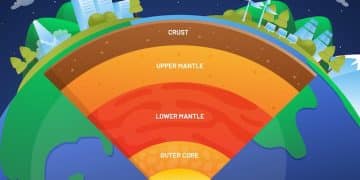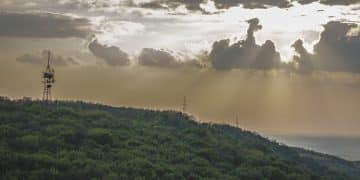US Deforestation: Protecting Forests & Biodiversity

Advertisements
The escalating impact of deforestation on US ecosystems poses complex challenges to biodiversity and climate stability, necessitating immediate, comprehensive protective measures and sustainable land management practices to safeguard vital natural resources for future generations.
Advertisements
The vast and varied landscapes of the United States, from the ancient forests of the Pacific Northwest to the vital woodlands of the Southeast, are foundational to the nation’s ecological health. Yet, these critical ecosystems face an ever-present threat: the impact of deforestation on US ecosystems: what can be done to protect our forests and biodiversity? This exploration delves into the realities of forest loss, its far-reaching consequences, and the tangible steps being taken—and those still needed—to preserve these invaluable natural assets.
Understanding Deforestation in the US Context
Deforestation, often associated with tropical rainforests, is also a significant issue within the United States, albeit manifesting differently. It involves the permanent conversion of forest land for other uses, such as agriculture, urban development, or infrastructure. While the US saw a period of net reforestation in the 20th century, recent decades indicate a complex picture where forest loss continues in specific regions and for particular types of forests.
Advertisements
Historical exploitation during westward expansion drastically altered much of the contiguous US forest cover. By the early 20th century, extensive logging reduced old-growth forests to a fraction of their original size. Efforts in conservation and sustainable forestry have since helped recover some of this loss, yet new pressures arise, particularly from urban sprawl and intensified agriculture. The scale and nature of deforestation today differ from historical patterns; it is often more fragmented, impacting connectivity between habitats, even if the total area lost seems smaller.
Drivers of Forest Loss across the Nation
The forces driving deforestation in the US are diverse, reflecting the country’s varied geography and economic landscape. Understanding these drivers is crucial for formulating effective conservation strategies. Each region faces unique pressures that contribute to the ongoing decline of forest cover.
- Urbanization and Suburban Sprawl: As populations grow and expand, forests on the outskirts of metropolitan areas are often cleared to make way for housing, commercial developments, and supporting infrastructure. This is particularly prevalent in states with rapidly expanding cities.
- Agricultural Expansion: While less dominant than in other parts of the world, agricultural land conversion still contributes to deforestation, especially for commodity crops or livestock grazing in areas where forest margins are suitable for farming.
- Resource Extraction: Mining operations, oil and gas drilling, and associated infrastructure like pipelines can lead to localized but significant forest removal, often with lasting environmental impacts.
- Wildfires: Though natural, the increasing frequency and intensity of catastrophic wildfires, often exacerbated by climate change and past management practices, can permanently alter forest ecosystems, preventing natural regeneration.
Each of these drivers presents a distinct challenge requiring tailored solutions that balance economic needs with ecological preservation. For instance, urban planning can incorporate green infrastructure, and agricultural policies can promote sustainable land use to minimize forest conversion. Addressing these root causes is paramount to effective forest protection.
Ultimately, a comprehensive understanding of these underlying drivers allows for more targeted and effective conservation efforts. Ignoring them would mean merely treating symptoms rather than addressing the core problem of forest loss. This nuanced approach acknowledges the complexities inherent in balancing human development with environmental stewardship.
Ecological Ramifications of Forest Loss
The ecological ramifications of deforestation in the US are profound and far-reaching, extending beyond the immediate loss of trees. Forests are intricate ecosystems, serving as cornerstones for biodiversity, climate regulation, and hydrological cycles. Their disappearance triggers a cascade of negative effects that destabilize natural systems and impact human well-being.
One of the most immediate consequences is the severe impact on biodiversity. Forests are home to a vast array of plant and animal species, many of which are highly specialized and depend entirely on specific forest habitats for survival. When these habitats are destroyed or fragmented, species lose their homes, food sources, and migratory routes, leading to population declines, local extinctions, and a significant reduction in overall biodiversity. This loss weakens ecosystem resilience and function.
Impact on Biodiversity and Wildlife Habitats
The interconnectedness of forest ecosystems means that even localized deforestation can have ripple effects. Birds that rely on specific tree species for nesting or foraging may be displaced. Mammals requiring large, contiguous forest blocks for their ranges face increased risk of road mortality or conflict with human settlements. Amphibians and insects, highly sensitive to environmental changes, are often among the first to show signs of decline, indicating broader ecological distress.
- Habitat Fragmentation: Forest clearance often leaves behind isolated patches of woodland, making it difficult for wildlife to move between areas. This genetic isolation can lead to inbreeding and reduced fitness, making populations more vulnerable.
- Loss of Endemic Species: Many species, especially plants and insects, are found only in specific forest types or regions. Their habitat loss means their complete disappearance from the planet.
- Disruption of Food Webs: The removal of key plant species or a decline in herbivore populations can unravel complex food webs, affecting predators and decomposers alike, destabilizing the entire ecosystem.
Beyond biodiversity, deforestation significantly impacts climate regulation. Forests act as vital carbon sinks, absorbing vast amounts of carbon dioxide from the atmosphere through photosynthesis. When forests are cleared, not only is this carbon absorption capacity lost, but the carbon stored in the trees is also released back into the atmosphere, primarily through burning or decomposition. This contributes to increased greenhouse gas concentrations, accelerating climate change and its associated effects like extreme weather events.
Furthermore, forests play a critical role in regulating water cycles. They intercept rainfall, reduce surface runoff, and promote groundwater recharge. Deforested areas often experience increased soil erosion, leading to sedimentation in rivers and streams, reduced water quality, and increased risk of floods. The loss of tree cover also contributes to higher local temperatures due to the absence of shade and evapotranspiration, creating drier, hotter conditions that further stress remaining ecosystems. The cumulative effects of these impacts underscore the urgency of addressing deforestation as a multifaceted environmental crisis.
Economic and Social Dimensions of Forest Loss
The economic and social dimensions of deforestation in the US are intricate, extending beyond environmental concerns to touch upon livelihoods, community well-being, and future prosperity. While the immediate economic gains from converting forest land might appear attractive for specific industries or developers, the long-term cumulative costs often outweigh these short-term benefits, affecting diverse sectors and communities across the nation.
One significant economic impact stems from the loss of ecosystem services provided by forests. These services, such as clean air and water, soil fertility, and pollination, are often taken for granted until they are degraded or lost. For instance, forested watersheds provide natural filtration for drinking water, reducing the need for costly treatment plants. When forests are cleared, water quality declines, imposing higher costs on municipalities and affecting public health. Similarly, healthy forests support timber industries, tourism, and outdoor recreation, all of which contribute significantly to local economies. Their degradation diminishes these economic opportunities and can lead to job losses in related sectors.
Impact on Local Economies and Indigenous Communities
Local economies, particularly in rural areas, can be heavily dependent on forest resources. Logging communities, for example, rely on sustainable forestry for their livelihoods. However, unsustainable logging practices or the permanent conversion of forest land can deplete these resources, forcing communities to seek alternative economic bases or face decline. The social fabric of these communities is often deeply intertwined with their natural surroundings, making forest loss a direct threat to their way of life.
- Erosion of Livelihoods: Jobs in forestry, recreation, and related industries decline as forest resources diminish, leading to economic hardship and out-migration from rural areas.
- Loss of Cultural Heritage: Many Indigenous communities in the US have strong cultural, spiritual, and economic ties to ancestral forest lands. Deforestation obliterates sacred sites, traditional food sources, and medicinal plants, severing vital connections to their heritage and identity.
- Increased Healthcare Costs: Degraded ecosystems can lead to poorer air and water quality, potentially causing respiratory illnesses, waterborne diseases, and other health issues that increase healthcare burdens on communities.
Beyond direct economic and cultural impacts, deforestation can exacerbate social inequalities. Vulnerable communities, including low-income populations and marginalized groups, are often disproportionately affected by environmental degradation. They may live closer to deforested areas, experience higher exposure to pollution, or have fewer resources to cope with the economic and health consequences of ecosystem loss. This creates a cycle of environmental injustice that perpetuates broader societal challenges.
Furthermore, the long-term economic stability derived from sustainable forest management, which includes non-timber forest products like mushrooms, berries, or medicinal plants, is often undervalued in short-term profit considerations. Investing in forest conservation and restoration, conversely, can create new green jobs and foster resilient, diversified local economies. Recognizing and quantifying these broader economic and social costs is essential for making informed policy decisions that prioritize sustainable land use over short-sighted economic gains, ensuring the well-being of both people and planet.
Current Conservation Efforts and Policies
Recognizing the multifaceted challenges posed by deforestation, the United States has a robust framework of conservation efforts and policies aimed at protecting its forests and biodiversity. These initiatives span various levels of government, involve numerous non-governmental organizations (NGOs), and often include public and private sector partnerships. While progress has been made, the dynamic nature of threats necessitates continuous adaptation and enhancement of these protective measures.
Federal legislation, such as the National Forest Management Act, plays a crucial role in guiding the management of national forests, emphasizing sustainable practices, biodiversity protection, and public access. Agencies like the US Forest Service oversee vast tracts of public land, implementing management plans that range from maintaining wilderness areas to supporting sustainable timber harvesting. The Endangered Species Act provides a critical safety net for species facing extinction, often leading to habitat protection measures that benefit forested areas.
Government Programs and Non-Profit Initiatives
Beyond legislation, numerous government programs provide incentives and support for private landowners to conserve forests. For instance, the Forest Legacy Program helps states protect environmentally important forest lands from conversion to non-forest uses through conservation easements or direct acquisition. The Conservation Reserve Program encourages farmers to convert environmentally sensitive cropland to forest or grassland, preventing erosion and enhancing wildlife habitat.
- National Forest System Management: The US Forest Service manages 193 million acres of national forests and grasslands, balancing timber production, recreation, and conservation through comprehensive land management plans.
- Land Trusts and Conservation Easements: Private land trusts acquire and protect critical forest habitats, often working with landowners to establish conservation easements that legally limit development while keeping land in private hands.
- Restoration Projects: Initiatives like the Great American Outdoors Act fund large-scale forest restoration, reforestation, and ecological enhancement projects, particularly in areas impacted by wildfires or disease.
Non-profit organizations are pivotal in these conservation efforts, often bridging gaps in government action and pioneering innovative solutions. Groups like The Nature Conservancy, National Audubon Society, and local land conservancies purchase critical habitats, engage in ecological restoration, advocate for stronger environmental policies, and educate the public on the importance of forest conservation. Their work often involves scientific research, community engagement, and fundraising to support on-the-ground projects.
Collaboration between state and local governments, federal agencies, and NGOs is also essential. State forestry agencies often provide technical assistance to private landowners, develop forest management plans, and address local specific issues such as invasive species or wildfire risk. Local zoning laws and comprehensive plans can influence development patterns, aiming to minimize forest conversion and protect green spaces within urbanizing areas. These combined efforts create a layered defense mechanism for US forests, demonstrating a collective commitment to their preservation and sustainable use for future generations.
Sustainable Forestry and Reforestation Strategies
While protecting existing forests is paramount, sustainable forestry and reforestation strategies are equally vital components of a comprehensive approach to mitigating the impact of deforestation on US ecosystems. These strategies focus on proactive management that ensures forests remain productive and ecologically sound for the long term, coupled with efforts to restore forest cover in degraded or cleared areas. They represent a shift from purely extractive practices to a more holistic view of forest resources.
Sustainable forestry involves managing forests to meet current timber and non-timber product needs without compromising their ability to provide those benefits in the future. This includes practices such as selective logging, which extracts individual trees or small groups of trees rather than clear-cutting large areas, thereby maintaining forest structure and biodiversity. It also encompasses protecting water quality, managing for wildlife habitat, preventing soil erosion, and promoting forest health through careful disease and pest management. Certification programs, such as those offered by the Forest Stewardship Council (FSC) or the Sustainable Forestry Initiative (SFI), provide third-party verification that forest products come from responsibly managed sources, enabling consumers to make informed choices.
Innovations in Forest Management and Restoration
Advancements in technology and ecological understanding are continually enhancing sustainable forestry practices. Remote sensing and geographic information systems (GIS) allow for more precise mapping and monitoring of forest health and timber inventories. Genetic research aids in developing disease-resistant tree species for reforestation. These innovations help forest managers make more informed decisions that optimize both timber yield and ecological health.
- Agroforestry Systems: Integrating trees with agricultural crops or livestock on the same land provides multiple benefits, including soil conservation, biodiversity enhancement, and diversified income streams for landowners.
- Assisted Natural Regeneration: Instead of planting new trees, this method focuses on removing barriers to natural forest regrowth, such as controlling invasive species or reducing competition, allowing ecosystems to restore themselves more efficiently.
- Mass Timber Construction: Promoting the use of engineered wood products like cross-laminated timber (CLT) encourages demand for sustainably harvested wood, providing economic incentive for responsible forest management over non-renewable building materials.
Reforestation, or replanting trees in areas where forests have been removed, is another critical strategy, particularly in areas affected by severe wildfires, urban expansion, or past unsustainable logging. It involves selecting appropriate native tree species, preparing sites, and often includes post-planting care to ensure successful establishment. Large-scale reforestation initiatives can help restore carbon sequestration capacity, rebuild wildlife habitats, and protect watersheds, slowly reversing the damage caused by deforestation.
However, reforestation is not simply about planting trees; it’s about restoring ecological function. This often means considering the entire ecosystem, including soil health, hydrological patterns, and the potential for natural succession. Challenges remain, such as sourcing diverse, locally adapted seeds, dealing with invasive species, and ensuring long-term funding for maintenance. The combination of rigorous sustainable management of existing forests and ambitious, ecologically sound reforestation efforts is crucial for safeguarding the future of US forests and their invaluable contributions to the nation’s environmental well-being.
The Role of Policy and Public Engagement
Ultimately, addressing the impact of deforestation on US ecosystems requires more than just on-the-ground conservation; it demands robust policy frameworks and dynamic public engagement. Policies provide the legal and regulatory backbone for protection and sustainable use, while public engagement ensures political will, financial support, and a collective commitment to forest stewardship. These two pillars are interdependent, with advocacy from an informed public often driving legislative changes and policy enforcement.
Effective policy can take many forms, from land-use planning regulations that limit urban sprawl into forested areas to financial incentives for private landowners to engage in conservation easements or sustainable forestry. It also includes strengthening environmental impact assessments for large development projects to ensure that potential forest loss is thoroughly evaluated and mitigated. Policies related to climate change, such as carbon pricing or renewable energy mandates, can indirectly reduce pressure on forests by diminishing the need for land-intensive fossil fuel extraction.
Advocacy for Stronger Environmental Legislation
Advocacy groups and environmental organizations play a vital role in pressuring lawmakers to enact stronger environmental legislation and ensure existing laws are adequately enforced. This can involve lobbying efforts, public awareness campaigns, and even litigation when necessary to protect forests from harmful activities. Public outcry and sustained advocacy can bring critical issues to the forefront of political discourse, leading to tangible policy changes that benefit forest ecosystems.
- Green Infrastructure Mandates: Policies encouraging or requiring green infrastructure in urban planning can reduce reliance on traditional development that clears forests, promoting tree-lined streets, urban parks, and natural stormwater management.
- Strengthening the Lacey Act: This federal law combats illegal trafficking of wildlife and plants. Strengthening its enforcement can deter the trade of illegally harvested timber, thus reducing the economic incentive for unsustainable logging both domestically and internationally.
- Investment in Research and Monitoring: Government funding for scientific research on forest health, carbon sequestration, and biodiversity provides critical data to inform evidence-based policy decisions.
Public engagement is equally critical. An informed and active citizenry can influence policy decisions through voting, contacting elected officials, and participating in public comment periods for proposed projects. Environmental education programs raise awareness about the value of forests and inspire individuals to adopt sustainable practices in their daily lives. Consumer choices, such as purchasing sustainably certified wood products or supporting companies committed to deforestation-free supply chains, also send powerful market signals that can drive corporate responsibility.
Furthermore, active community participation in local forest planning and decision-making processes fosters a sense of ownership and can lead to more tailored, effective conservation outcomes. Volunteer efforts in reforestation projects, trail maintenance, or species monitoring directly contribute to forest health. By empowering individuals and communities to become stewards of their local landscapes, public engagement transforms environmental protection from an abstract concept into a tangible, collective responsibility. The interplay of comprehensive policy and robust public engagement creates a dynamic force, capable of enacting meaningful and lasting change in the fight against deforestation.
Future Outlook and Challenges
The future outlook for US forests is a complex interplay of persistent challenges and emerging opportunities for enhanced protection. While past conservation efforts have yielded significant successes, new threats continue to emerge, demanding adaptive strategies and sustained commitment. Understanding these challenges is crucial for charting a course towards a future where US forests thrive and continue to provide their invaluable ecological and societal benefits.
Climate change stands as perhaps the most overarching and pervasive challenge. Rising temperatures, altered precipitation patterns, and increased frequency of extreme weather events like prolonged droughts and intense wildfires pose existential threats to forest ecosystems. These shifts can stress trees, making them more susceptible to pest outbreaks and diseases, or directly leading to massive forest loss, particularly in the arid western regions. Adapting forest management to a rapidly changing climate, including fostering climate-resilient species and diversifying forest stands, is a monumental task.
Emerging Threats and Opportunities for Innovation
Beyond climate change, other emerging threats include invasive species, which can outcompete native plants and disrupt forest ecosystems, and continued pressure from urban development and infrastructure expansion, especially in ecologically sensitive areas. The economic allure of converting forest land for other uses remains a constant challenge, requiring strong policy disincentives and attractive alternatives for landowners.
- “Fireshed” Management: Shifting from battling individual fires to managing entire “firesheds” through controlled burns, mechanical thinning, and community engagement to reduce fuel loads and create more resilient landscapes.
- AI and Satellite Monitoring: Leveraging artificial intelligence and advanced satellite imagery for real-time monitoring of deforestation and forest health, allowing for quicker intervention and more precise conservation efforts.
- Payments for Ecosystem Services (PES): Developing market-based mechanisms where landowners are compensated for providing valuable ecosystem services, such as carbon sequestration or water quality protection, from their forested lands.
Despite these daunting challenges, there are significant opportunities for innovation and strengthened conservation. Advances in ecological restoration science offer new methods for rehabilitating degraded forest lands. The growing public awareness of climate change and biodiversity loss could translate into increased political will and funding for conservation initiatives. The development of nature-based solutions, which harness the power of ecosystems to address societal challenges, presents pathways for integrating forest protection into broader sustainability goals.
The future of US forests will depend on a multi-pronged approach that includes continued investment in scientific research, adaptive management practices that account for climate change, effective policy enforcement, and robust international cooperation to address global drivers of deforestation. Perhaps most importantly, it requires a collective re-evaluation of humanity’s relationship with nature, recognizing forests not merely as resources to be exploited, but as integral components of a healthy and sustainable planet, deserving of utmost protection and thoughtful stewardship for generations to come. The journey is complex, but the imperative to act is clear.
| Key Point | Brief Description |
|---|---|
| 🌳 Biodiversity Loss | Deforestation destroys habitats, leading to species decline and ecosystem instability. |
| 💨 Climate Impact | Forest removal releases stored carbon, contributing to greenhouse gas emissions and climate change. |
| 💲 Economic & Social Cost | Loss of ecosystem services, livelihoods, and cultural heritage, impacting communities. |
| 🛡️ Solutions & Policy | Conservation efforts, sustainable forestry, reforestation, and strong policies are essential. |

Frequently Asked Questions About US Deforestation
▼
While historically logging was dominant, the primary driver of current deforestation in the US is often linked to urban and suburban expansion. As populations grow, forests on the periphery of cities are converted for housing, commercial developments, and infrastructure, leading to significant habitat fragmentation and localized forest loss across various regions.
▼
Deforestation in the US affects climate change in two main ways: by reducing the capacity of forests to absorb carbon dioxide from the atmosphere (carbon sinks) and by releasing stored carbon when trees are cleared, burned, or decompose. This contributes to an increase in greenhouse gases, intensifying global warming and its diverse impacts.
▼
Yes, numerous federal and state laws protect US forests, including the National Forest Management Act and Endangered Species Act. These laws regulate forest management, protect critical habitats, and support sustainable practices on public and private lands. Additionally, conservation easements and land trusts play a critical role in safeguarding private forest holdings from development.
▼
Sustainable forestry involves managing forests to meet current needs for timber and other resources without compromising their ability to provide those same benefits in the future. Practices like selective logging, reforestation, and protecting biodiversity ensure long-term forest health and productivity, mitigating the need for clearing new forest land while supporting economic benefits.
▼
Individuals can contribute by supporting organizations working on forest conservation, advocating for strong environmental policies, and making sustainable consumer choices (e.g., buying certified wood products). Reducing personal carbon footprint, conserving water, and participating in local reforestation efforts or community science projects also significantly aid forest protection and biodiversity.

Conclusion
The imperative to protect US forests and biodiversity is clear and multifaceted. As a nation, we face ongoing challenges from urban expansion, climate change impacts, and other pressures that threaten these vital ecosystems. However, through a combination of robust policy, innovative sustainable practices, and committed public engagement, there is a clear path forward. Prioritizing conservation, investing in reforestation, and supporting the intricate web of life that thrives within our woodlands are not merely environmental choices; they are fundamental investments in the long-term ecological health, economic stability, and social well-being of the United States. The future resilience of American landscapes hinges on our collective ability to act as responsible stewards of our invaluable forest heritage.





